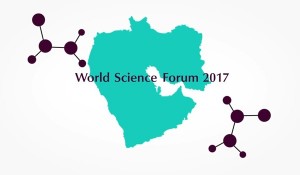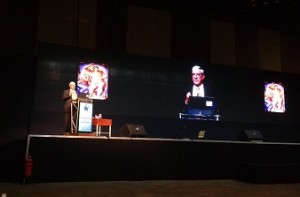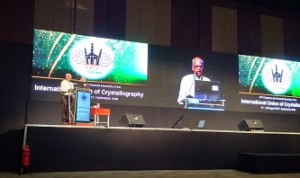 Dr Michele Zema, IUCr and Dr Jean-Paul Ngome-Abiaga, UNESCO
Dr Michele Zema, IUCr and Dr Jean-Paul Ngome-Abiaga, UNESCO
Synchrotron light sources are comparable to super microscopes that probe the inner structure of matter. They produce very intense pulses of light (from infrared radiation to X-rays), with wavelengths and intensities that allow detailed studies of objects ranging in size from human cells to viruses and proteins, down to atoms, with a precision that is not possible by other means. They allow researchers to investigate the structure and properties of a wide range of materials, from proteins to provide information for designing new and better drugs, probing novel materials for biotechnology, analyzing soils for green agriculture, to engineering applications, and the examination of archeological artifacts.
Because of their high costs and multidisciplinary use, large-scale synchrotron light sources facilities provide strong opportunities for integration through networking and cost-sharing, and promote multi-disciplinary collaboration with the wider global community, while promoting science diplomacy and peace at large.
Thus, light sources have become prime enablers of scientific and technological progress and innovation, conducive to sustainable development in line with the United Nations 2030 Agenda.
Through a project entitled Utilisation of light source and crystallographic sciences to facilitate the enhancement of knowledge and improve the economic and social conditions in targeted regions of the world, the International Council for Science (ICSU) is partnering with the International Union of Pure and Applied Physics (IUPAP) and the International Union of Crystallography (IUCr) to enhance Advanced Light Sources (AdLS) and crystallographic sciences in Africa, Mexico and Caribbean and Middle East (LAAMP).
You can read more about the LAAMP project here and its kick-off meeting at IUCr2017 here.
A thematic session by LAAMP entitled “Light sources and crystallographic sciences for sustainable development” has been approved to be part of the programme of the next World Science Forum which will be held at the King Hussein Bin Talal Convention Centre, Dead Sea, Jordan, November 7-11, 2017.
The session will showcase how light sources have revolutionized research in many science and technology disciplines, and has successfully contributed to the socio-economic development of countries and regions by:
- Creating international scientific communities
- Improving education and creating new job opportunities
- Discussing next steps following the establishment of light sources in the South (mainly Africa and Latin America) while learning from the experience of SESAME
- Increasing awareness for decision-makers of the major advances light sources can bring to regions and the identification of the best locations for the sustainable development of such infrastructure
- Advocating, through global initiatives such as the International Year of Crystallography and the International Year of Light
- Developing a critical mass of highly qualified human capital (including the African science diaspora) needed to reach the Sustainable Development Goals (SDGs) and regional framework agreements like the African Union Agenda 2063
The overall objective of the session is to portray a scalable model for light sources initiatives in the developing regions. The outcome is designed to empower and inspire researchers, scientists, engineers, technologists and policy makers to take proactive roles in their countries and regions to drive towards a densified science cooperation to improve international relations between countries and to develop the human capacity that enables researchers in the Global South to get the most from light sources, and to be meaningful contributors to the 2030 Agenda for sustainable development.

